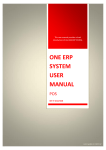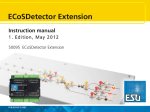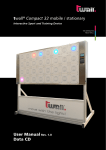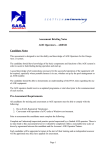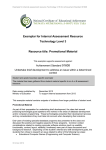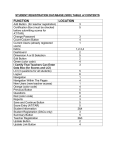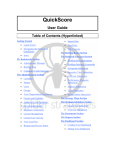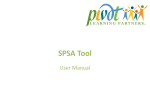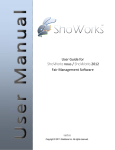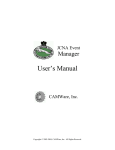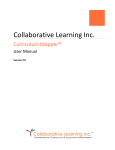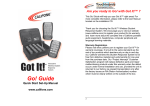Download Student 1
Transcript
Investigating the Client and Issue Why have you selected these clients? After considering several clients with data management issues and doing a PMI, I chose these clients and their project because I enjoy sport, I participate in sport in and out of school and I believe being active is important. I also have a strong interest in giving everyone the chance to participate in what they want to at the Athletic Sports day. I believe that these clients have a real need to improve the way they process the school Athletic Sports entries and I can create a solution that will benefit students and teachers throughout the school. What is the client issue? That the School does not currently have a database to hold the athletic sports entry form information, heats for track events, finals, as well as championship and house points. And to this present day this process is done manually, and is very time consuming. Also the current process wastes heaps of paper and we are an Enviro-School, so we need to do something to cut down the paper wastage at our school. What is the background to the issue? Client 1 prints and hands out the entry forms to the form teachers where they get their students to fill in what they want to compete in at sports day, this is then gathered and given back tto process the entry forms manually onto the computer, this is where different spreadsheets are created for different events and age categories. These spreadsheets include age, house, name, which heat and the results. Once the spreadsheets are completed they are given to the officials on the day to fill in once the event has taken place. How long has it been an issue? This has been an issue for many years, as the sports department has not improved in the way of processing the information in an efficient technological way. All teachers and students at the school now have laptops and it makes sense that the school should use this access to technology to improve the Athletic Sports entry process. How big of an issue is it? This issue is very time consuming, and takes away time for arranging the day for Teacher H and Teacher S. It puts a lot of pressure on the two teachers to get it done in a certain amount of time so that the teachers that record the results on the day are aware of what they are doing and who they are recording. What environment will this solution be used in? The students could receive the entry forms via their school email addresses and it could also be put on the school intranet. All students now have a laptop as part of our School laptop programme, so on-line access to the entry forms will not be an issue. This will be used in the sports office on Teacher S laptop, when completing the process of collecting and collating the entry forms. Then, the database will be used on the Athletic Sports day on one of the teacher’s laptops at the sports ground. Also, if this solution is carried out and the client does decide to use this process it can be used for school Swimming Sports as it is in the same context and is based around the same type of information that is used and needed at the Athletics Sports day. Who will be using this solution? All the students in Years 7-13 who enter the Athletic Sports, Teachers in the Sports Department, the two teachers collecting and tallying the results on the day of Athletic Sports, and also Teacher M. who works in the office and she will be using the final results to present them in the school newsletter. Research – Existing Solutions Swimming Database My Digital Technology teacher showed the class the swimming database for the local swimming club. I believe this database was easy to follow, filled with a lot of information which was sorted neatly and efficiently, this is what I want to pursue through the creation of my database, and strongly relates to what my clients have requested. The information provided in the database fitted all the needs and wants of the users and strongly showed what was needed and what wasn’t needed, the information was very accurate and relevant. This is also, once again, what I want my database to be like as accuracy and relevance are important database considerations. School Database When one of the Guest speakers (client 1) came into our class, they went through the school database which linked with other databases needed for and around the school, some of these databases were external such as the NZQA website and the assessment results, and some being internal, such as the student database providing information such as students timetable and background information, these get used by all teachers. I will need to import and export data between student entries, the database and final results. Being able to link data between applications is important data management consideration. It makes data management more efficient and reduces errors. I think the layout and efficiency of this database is very effective. On-line Database – Guest Speaker 2 Quality Assurance is another important aspect for any database because without quality assurance, the database could be inaccurate and provide the wrong information. The way Guest 2 ensures that the quality is up to the highest standard is a lot of testing. Testing becomes a huge part of a database developer’s process all throughout their projects as it also is reassuring them that they are completing the project accurately. Giving the solution to ‘fresh eyes’ such as different developers or others to test helps pick up on anything that may need to be changed or enhanced. Therefore, quality assurance is a serious and important aspect that is vital for a database solution, such as the one I will create. This is an example of a database design, for a database that Guest 2 developed for a client. This screen shot is showing the tables that are linked with an easier view of the information involved in the tables. My database will also have many tables that link with each other and relate to all sorts of information. I could use this format to show my clients which tables and information is related, to show how the information is efficiently and accurately transported through each table. Context Considerations From our class work and my initial research into data management concepts, having guest speakers discuss database solutions, analysing existing solutions and my own initial investigation into the issue, I have determined that the following are key context considerations for my project: 1. Skills: In order to create this solution I will need to have the skills required on the computer in Microsoft Excel and Microsoft Access, for example; to create any queries, macros, formulas on a database and spreadsheet. Without these skills I will not be able to create the final solution, this is a very important key factor as without any skills nothing can be created. 2. Usability: To be able to have an easy and efficient process is very important, because if the teachers or helpers did not know how to use this solution on the day it would add more work by them trying to find out how to do it or even complete it manually. To make this easily used I can add navigation forms, buttons, notes in the spreadsheets and database, highlight important keys, such as macros, and keep the format simple but still effective. 3. Content: The content included in this solution will be both stored in Microsoft Access, with the queries to find which event and what age category, and Microsoft Excel, which is the imported information and where the results are filled. The content in these programmes need to be specific and accurate, so they are exported properly and relate to all information. 4. Accuracy: It is important to keep my data accurate in the database and spreadsheet, if the data is not accurate it can change all aspects, such as; the placing’s, 1st 2nd and 3rd, the amount of points gained, etc. To keep everything accurate I will need to take care in creating each macro and query because if I miss anything out or add anything that isn’t needed I will not collect the correct data needed for the final outcomes on the Sports Day. I will make sure to provide ways that users can input information accurately on the day and reduce any duplicate data through related tables. 5. Time: Time is an important key factor, it is important for me to effectively plan my time with what I have already achieved, what I need to achieve and how I am going to do it, this can be done by the Gantt Charts created for terms 1 and 2. I will manage my time by not only working on my solution during school times, such as class, and study, but to take it home and work on it throughout the week and weekends, as well as holidays. 6. Relevant: The information included in this database needs to be kept simple and relevant, having any other information in and around the database will cause confusion and will seem ‘over done’. I will keep it simple with only having the fields that are needed and also include any important notes to the side to show how to use any formulas or macros. This is all relevant information, I do not want the database to be busy, as it would make it look as if it was difficult to use. 7. Quality Assurance: To be able to prove that I can produce this database to a high quality I will need to assure my clients that I have created all sorts, queries and formulas correctly. By doing so I will show testing procedures throughout the creation of the final database solution, this will help keep me aware that the information I have inputted into the database is accurate and the formulas fit with the information given. Athletic Sports Day Client Survey What I can do for you: 1. Set up a system for collecting entries, this can be done as a PDF Form and sent out to students via school email where they can fill out and send back. 2. Create a database where data is imported from the PDF Forms, this will sort out the heats, finals and championship points This is just to make the process a lot more efficient and less manual work. See if I can get a copy of the entry spreadsheets that are used now. What I need to know: What is the process you use now? What are the things you want to keep from that? What colour schemes, fonts, etc. would you like to be used? Who other than you will be a decision maker in this? Would you like to keep the same entry form? Or make any changes? What is the best way to contact you? What type of computer will you use this on? PC or Mac? Also, what year are you? programmes? E,g Microsoft Office 2010 Client Meeting 2 I have met with my clients, and discussed their existing solutions in comparison to the plan at which I am working towards. I created a small questionnaire (see below) and left it open for them to tell me what their beliefs and needs were. This was things such as; a PDF form that gets sent over the Internet to all students school email addresses, create a database and/or spreadsheet to control the heats, finals, championship points and house points, as well as finding students who have not filled in their forms or who are not competing in any categories, also sending back an email to each student to inform them of what they have decided to compete in on the day (this can be done by a mail merge). Included in this solution, there needs to be a strong positive attitude and presentation, this keeps the students excited and ready to commit to a fun athletic day within the school, this can be done through images, colours, and fonts presented on the PDF form. Also, students enjoy using technology and their new laptops, so using an on-line form instead of a paper form will be more appealing to them. When I met with the client I received a couple of their existing spreadsheets to show me the process that they go through and what information is included, for example: with the spreadsheet for sprints, there are columns for the lane number, name, house, time and the placing. I also received an athletic sports booklet that consists of all information to do with the sports day. Client Meeting 3 After my initial survey, I have met with my clients, in their sports office, and discussed a brief outline of what I can do for them, including a more efficient process of collecting and collating the entry forms and information, talking about the client’s beliefs, values and attitudes by discussing the format, appearance and effects. We also discussed what they wanted to add and take away from their existing solution, for example, to create a deadline for the entry forms, to create a spreadsheet to show the people who have not yet entered in any events, etc. Stakeholder Consultation I have frequently talked to my Digital Technology teacher (who is also stakeholder using the solution on the day) about the different processes which I can trial for the final solution. As a stakeholder who is aware of the present process, it allows us to talk about the changes and improvements that can be created for a more efficient and worthwhile solution. We discussed two different ways in which I could implement a solution for the Athletic Sports day. Client Meeting 4 I met with my two key stakeholders and presented two options to them: One way this can be implemented is by using a PDF form for entry information, then sending it out to all students, the PDF form then being imported into a database with the information of what everyone is entered in and also who isn’t entered in any events. Then once all information is stored it could be exported into different spreadsheets containing each field and track event, with the names, houses and placings. This is where the teachers can put in the results so Excel can sort and find who are in finals, who have received points for getting a place and then the final house points. After the results and points have been made, it will then need to be exported into a Word Document or again a PDF form to send through to Client 1 where the information is collated and presented in the schools newsletter. The second way of processing my solution could be to once again use a PDF form to send to students to gather their entry information, then for the information to be put in a database, but for it to stay in a database. The database would consist of different forms, queries and macros to show the different groups, results, points and orders of each event and to also make it more efficient by using macros to find out specific information, such as who is to go into a final. Then once it is all completed in the one database, to, again, export the information to a word or PDF form to send through to Client 1 to present in the school newsletter. Stakeholder Consultation I worked on conceptual designs as to how the data would connect in each of the possible solutions. Because in the past, they had been using spreadsheets for entering the results, the key stakeholders and I thought at first it would be best to use spreadsheets in the solution. However, after working through the concepts and due to consultation with another stakeholder (my Digital Technology teacher), who does entry of results on the day, it was decided to make the solution using the second option and using Access only for the entries and results. This will now make it easier to use and more efficient for the users, and more understandable for the clients and stakeholders, as it will be done only in Microsoft Access and they won’t need to worry about any exporting between programmes to enter results. I have now updated my brief to reflect these changes. Updates to brief based on feedback from clients and stakeholders – The solution that I will be creating is a database for my clients who are the sports coordinator and director of the School, for the Athletic Sports Day. – The database will be created in Microsoft Access. – The database will include 3 different tables that will all relate with each other. There will be a Students Table, this will include the ID, First and Last Name, House and D.O.B. The ID will be linked to the next table, which is the Events Table; this will include the ID numbers that are included in each different event. The last table is for the Possible Events, this will include what events are available and whether they are a track or field event, this will help sort them into different forms in the database as the layout and content of the track and field events are different. – The forms will be presented in a list with the use of specific buttons that will help the users feel the database is more efficient, these buttons could be print, go forward, go back, top 8, etc. There will be a query set in the forms, which will be used to find the top 8 people in specific track events, which will send them through to another form for the finals. – – The track form will include: Lane, First and Last Name, House, Time, and Placing. The field form will include: First and Last name, House, Best Effort and Placing. – The results will be created as a report in Microsoft Access, which will be based on a query for points for each placing, 1st 2nd and 3rd, with each placing getting a different amount of points. Stakeholder Consultation – Demonstrating Solution I met with my stakeholders to show them the progress I had made on creating the solution and to see if they had any further questions or feedback. 1. On ‘the day’ I need to be able to print off heat lists and field event lists for teachers – what will this look like? Field event teachers need to be able to record distances as well. This is shown in this print screen, it is titled 800m Over 16. This is also what it will look like for the field events. It is a Multiple List Form that includes a Print Button, which is very efficient for any teacher who needs the sheet to fill in any distances or times. The teachers will record any data that is needed and hand it back to the specific teachers who work on the computers on the day at the sports ground. These two teachers will fill in any information that is required and the database will help format the distances and results which will give them the points and finals lists automatically. 2. How do the students log on? The students do not need to log on. What will happen is that the students will be sent an entry form through their school email and there will be a set form time where they will need to fill out the form even if they are only competing in fun events and not championship events. Then they will send it back and the data will be collected in an Adobe PDF response collector file and can be imported into the database. I first had some students in my Digital Technology class test the form and the process. I had to make a few changes from their tests and then I had some Year 11 students test this process again and it works really well. They had no problems with the using the form or the reply process. Once the students have filled their forms out they will send it back to the sender. From there, the forms will be collected into a Response File, this is an example of what a Response File looks like. There is a testing data in this form, only three students – but this is what it will look like although it will have a lot more data from the students throughout the school. This is where the information is held and is what you import into the database. 3. Can students enter in events on the day? Yes, I believe they can. The teacher on the specific event that someone may decide to enter on the day will just need to write the details on the specific printed form where the teachers working on the database will just need to add in the student so the form includes all her information. Response to stakeholder feedback I have made another set of buttons to make it easier for the users on the day of the event. Under the tabbed age categories are Add Student buttons, which can come in use when a student has decided to enter an event on the day. The Clients bought this up, therefore I believed it was necessary to have this option available for the users of this database as it makes it a lot easier to put in the students details and join them into an event. It is a form in which you only need to fill in their student ID and Name as well as which event they are entering. The student ID comes beside the name of each student, these ID’s are created at the beginning when the student enters into events from the Entry Form Final Brief The solution to be developed is an on-line entry system and database for my clients, who are the sports coordinator and HOD of PE of the School, for the School Athletic Sports Day. The teachers who must enter the results on the day are key stakeholders and the students in Years 7-13 who will need to use the solution to make their entries are wider stakeholders. This solution will provide benefit for all the key and wider stakeholders by making a more efficient system for entering, organising, storing and reporting results. It will also promote our wider School goals of reducing paper wastage and promoting use of digital technology. Specifications Relating to Context Considerations: To apply all knowledge and skills that I have presently with Microsoft Access and Adobe Acrobat Pro, if I come across any skills that I am not aware of I can ask my Digital Technology Teacher for any guidance and help and research in books and on the Internet – Skills: In order to create this solution I will need to have the skills required on the computer in Microsoft Access and Adobe Acrobat Pro. For example; to create any queries, macros, formulas on a database. Without these skills I will not be able to create the final solution, this is a very important key consideration as without any skills nothing can be created. Make sure the solution is more efficient, easy to run and easily updateable – Usability: To be able to have an easy and efficient process is very important, because if the students, teachers or helpers did not know how to use this solution on the day it would add more work by them trying to find out how to do it or even complete it manually. By having a main Navigation form that includes all information that is needed and having it presented in a simple yet effective layout, it makes it a lot easier to work throughout the database as the information is in one spot. The Navigation Form provides all forms just with a click of the mouse, it is tabbed under each different age category and includes all events, all top 8 and top 3 participants as well as close and printing buttons. The content in the database needs to be clear with all information relevant and accurate, as this could change all data for final results. All common codes of practice will need to be followed. – Content: The content included in this solution will be stored in Microsoft Access. The database includes 4 different tables that will all relate with each other. There is a Students Table, this includes the ID, First and Last Name, House, D.O.B and Age Category. The ID is linked to the next table, which is the Events Table; this includes the ID numbers that are included in each different event as well as their First and Last Name, Preliminary Results, Final Result and Total Points. The third table is for the Possible Events, this includes what events are available and whether they are a track or field event, this helps sort them into different forms in the database, as the layout and content of the track and field events are different. The fourth table, which was added to the specifications at the end of the development of the solution, is called Responses. This is where the information from the Entry Forms will be imported into via the external data process. This is where the information is held until the user has set up the entries in the main form. The forms will be presented in a list, known as a Multiple Items Form. There is a Navigation Form, which is tabbed under each Age Category with the list of different events; this is where the users will find the forms for each event in each age group. Also, on the Navigation form you can find a button on each tab which is named ‘Add Student’ this is where you can add any participant into the database that may have chosen to show up to an event on the day. In the Main Navigation Form there is a Set-Up Entries Tab, to help the user set-up the entries based in the Responses Table as well being able to delete any previous data from the year before or testing data. There are buttons based on queries, which can automatically input the information into the forms under each age category. These queries are called Append Queries, which take information from the Response table and put it into the Students and Event Entries so it can be found in the main form. There are queries, which can be accessed in the forms, which are used to find the top 8 people in specific track events, which will send them through to another form for the finals. The total points will be shown through the Event Entries Table. From the top 8 form and query, there is a close button, a print button and a top 3 button which then brings you into a form that shows the top placing’s of each event and the total points they have gained. The final results are created by a simple query that pulls the top 3 from each top 8 forms and sets them up from first to third where you can input the points. On-Line Entry Form To get the participants into the database there is an entry form, which will be sent out via the school email and will have a specified Friday form time to fill in this form and send it back to the Sports Office. This is sent via Adobe Acrobat Pro where the form is distributed to all students, then once they send all their forms back to the email it was sent from it will be added into a response file where the choices and the students names will be posted. This information gets imported into the database following the Text File External Data process (the steps to follow are in the user’s manual). The content in the database needs to be specific and accurate, so the database can provide reliable information. Accuracy: It is important to keep my data accurate in the database, if the data is not accurate it can change all aspects, such as; the placing’s, 1st 2nd and 3rd, the amount of points gained, etc. To keep everything accurate I will need to take care in creating each macro and query because if I miss anything out or add anything that isn’t needed I will not collect the correct data needed for the final outcomes on the Sports Day. This is where it is important to keep testing my database and on-line entry system. It also includes specifying the correct field formats to make sure the database will remain accurate. Calculated fields are used to help ensure accuracy, such as having an IF statement for the Age Category based on the student birthday, so that the students will not need determine their age category which caused accuracy problems in the past. Relevant: The information included in this database needs to be kept simple and relevant, having any other information in and around the database will cause confusion and will seem ‘over done’. I will keep it simple with only having the fields that are needed and also include any important notes to the side to show how to use any formulas or macros. This is all relevant information, I don’t want the database to be busy, as it would make it look difficult to use. The planning and development work will need to be completed by the end of term 2 and the final solution needs to be completed by the end of term 3. It will be important for me to manage my time wisely and make the most of the time we have at school – Time: Time is an important key factor, it is important for me to effectively plan my time with what I have already achieved, what I need to achieve and how I am going to do it, this can be done by the Gantt Charts created for terms 1 and 2. As well as creating my final solution before the end of term 3. I will manage my time by not only working on my solution during school times, such as class, and study, but to take it home and work on it throughout the week and weekends, as well as holidays. Testing procedures will need to take place during the development of the final solution to pick up on anything that may need to change – Quality Assurance: To be able to prove that I can produce this database to a high quality I will need to assure my clients that I have created all sorts, queries and formulas correctly. By doing so I will show testing procedures throughout the creation of the final database solution, this will help keep me aware that the information I have inputted into the database is accurate and the formulas fit with the information given. Fonts and Colour: The fonts chosen for the Database are and On-Line Entry Form are shades of blue and green. The main Navigation Form, will have a background of the screen being a light green, bordered by a darker shade. The buttons have a blue hover colour similar to the colour that is use for the background of the Title text. This is also the same for the tabs, when the mouse hovers over the tabs it will change to a blue colour similar to the text background. I have kept the same colour range throughout as it looks more effective and formal & fits in with the School’s image. Wider School Initiatives: The on-line entry system for Athletic Sports Day entries will promote wider initiatives around the school, such as being able to reduce paper wastage as we are an Enviro-school and to promote using digital technologies as we are now a full laptop school. Final Evaluation Against Brief By creating this database for the school Athletic Sports Day I have changed the initial process of manually importing and exporting all information from the students into spreadsheets and made it a lot easier for the sports coordinators and the users to run the Sports Day by creating a Database. This includes all students and what they are participating in, as well as the heats, finals, points and a system for the students to enter in the events they wish via email. This solution has been implemented and demonstrated to my client and stakeholders, where I gained positive feedback in which they confirmed the solution was fit for purpose and will be in demand for the years to come. By having such positive feedback it has made me aware that the school is going to use my solution starting next year, which will bring forward a strong and effective change to what the sports coordinators have previously used. I have met all the specifications and requirements that I have outlined throughout my briefs. I worked on the final outcome with all the possible skills and knowledge, up to my highest quality, this including over 100 queries and forms, which altogether brought forward the final main form. My key considerations have influenced throughout the whole development of my design; the usability has increased from my initial concepts as I have added in more forms and buttons based on queries to make it a lot more efficient and updateable, such as delete and add buttons along with print and close buttons. The content and accuracy of the content has been controlled significantly because the entry data is not keyed in manually from paper forms and the related tables, data input forms and other data validation has overall helped my final solution be at such a high quality and in such high demand. Throughout the development of my solution I have managed my time well and maintained a good schedule for the completion of my internal documentation and my final outcome. Viability of the Solution The database I created is very sustainable; it can be easily updated and can be used multiple times. The buttons in the Set up Entries tab are a clear example of this, ‘Delete Previous Entries’ and ‘Add Current Entries’. I wrote delete and update queries to create a more efficient way of deleting and collecting the information for each year. A way in which I tried to keep the database more sustainable and accurate was by using tooltips and having data restrictions, this was so data could not be repeated and also just to let the users know what they need to do and how they need to do it, an example of this is under the Date of Birth text box on the entry form: if the students entered their date in a wrong format it would therefore tell them how to enter it – this was needed because it had to be the same format as the database so it would link in together with the automatic age group. I have kept the database as simple as possible, therefore any resources or information required later on or for any maintenance, can be completed efficiently and effectively. One of my main stakeholders, my Digital Technology teacher is very aware of how the database is kept and controlled, therefore by having such high knowledge at the school it will help the implementation a lot easier next year when it comes to the first time for the clients to use it. To assist everyone, I have created a user’s manual which includes instructions on how to import the entries from the on-line student entry forms and how to use the database on the day. A positive environmental effect that this database has created is the huge decrease in the amount of paper. This process has decreased the number of paper use by over 500 sheets – this being due to the change of entry forms into an email process. Also, as the school has bought forward the new initiative of every student owning a Mac Book or any kind of laptop this process strongly relates to this and backs up the importance of having the student laptops. Overall, I believe my solution has taken away my clients issue and produced a more efficient process in which they were looking for. This database has shown to be a success in the way that I have solved all needs and wants, as well as working alongside my context considerations and specifications to which they have improved, but mainly that I have received such strong and positive feedback from not only my clients but my stakeholders, such as my Digital Technology Teacher and school students. This has shown me that I have achieved a solution that will help a lot of people in which they are extremely thankful for. Client Feedback ‘The Athletic Sports Database will be ideal for us at our school sports. Students have access to the entry forms and no paper is required which is ideal. This process makes it a lot easier to collate and access results than what we use currently. It is a lot more streamlined, which I find very effective’. ‘This solution could also be adapted to use for the school swimming sports.’ Key Stakeholder Feedback As a teacher who will use this solution on the day, I can see that this will greatly improve our accuracy and efficiency in getting out heats, finals and points and it will cause less stress in the control room. We will also be able to get the final results to the school office for publishing almost immediately. It has always been my job to calculate championship points and get results ready for publishing. Now, that task is virtually eliminated except for pressing a few buttons. I also like the way this helps to save paper and confusion on entry forms. Your digital form is presented in a much more up-to-date style and is easier to follow for the students, which has always been a challenge at form time (i.e. students didn’t know their age category which is calculated for them now by simply entering their birthday). Wider Stakeholder Feedback - Students Student J – The online entry system is a great improvement from the paper entry forms as it demonstrates efficiency and simplicity. It is relevant to the schools new computing initiative and is a great way to organise the entries for our sports day. Student S – I think this process of the online entry form is really good and will work well for the school. It is efficient and easy to use, as it is easy to understand as well as fill out. Student A – I used the new system for the sports day entries. I found it very easy to follow, simple to open, save and send back, and so very efficient all-round. It minimizes paper use, which is economical and environmentally friendly. I found this process to be an extreme improvement from the previous system.










